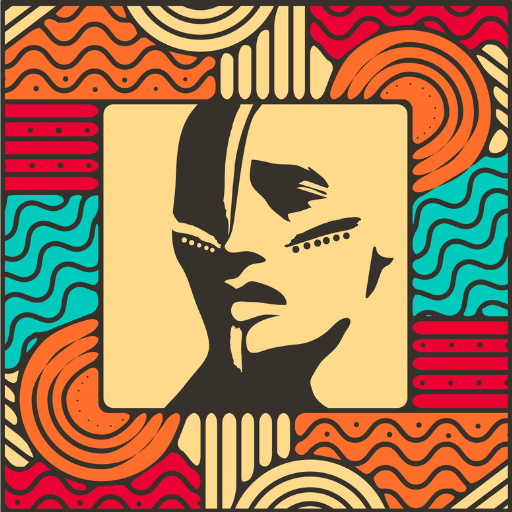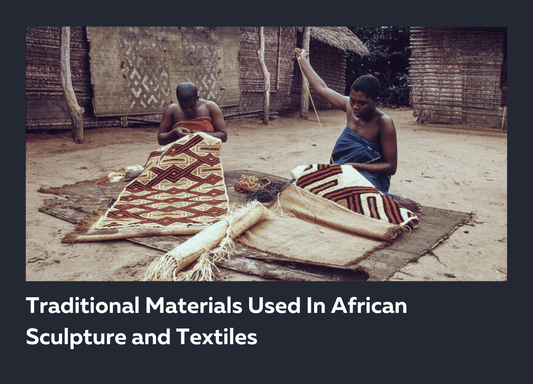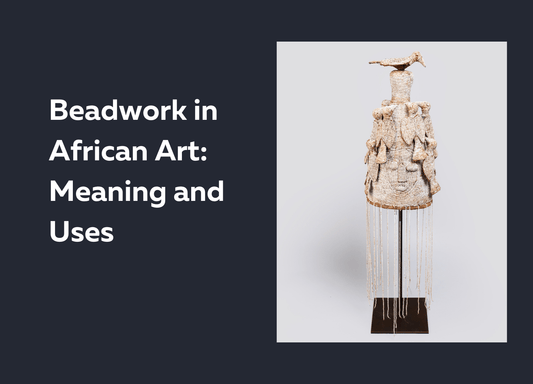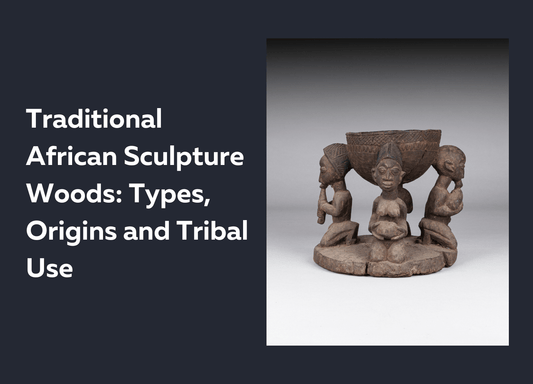
Traditional Materials Used in African Sculpture and Textiles
African art is inseparable from its materials. Whether carved, woven, cast, or painted, each artwork is a product of its environment, cultural purpose, and artistic heritage. Traditional African artists selected their materials with great intention, guided by symbolism, spiritual associations, local availability, and tribal custom. This article explores the primary materials used in African sculpture and textile arts, detailing the tribes, regions, and art forms associated with each.
Materials in African Sculpture
1. Wood
Wood is the foundational medium for African sculpture. It is light, durable, and spiritually significant. The choice of wood often varies by region and tribal preference.
- Yoruba (Nigeria): Use Iroko, Afara, and Òpẹ wood for religious statuary, masks, and Ere Ibeji twin figures. Each type has spiritual meaning: Iroko, for example, is believed to house spirits.
- Dogon (Mali): Carve ancestral figures and altarpieces from Néré (Parkia biglobosa) and shea wood, used in ritual altars and granary doors.
- Baule and Senufo (Côte d’Ivoire): Employ Obom and Ceiba woods for spirit spouse figures (Blolo Bian/Bla) and ceremonial masks.
- Makonde (Tanzania/Mozambique): Famous for hard ebony wood sculpture, especially family trees and spirit figures.
- Fang (Gabon/Cameroon): Use dense woods for reliquary guardian figures (Byeri), polished to deep sheens.
Use Cases: Ancestor veneration, divination, initiation ceremonies, fertility rites, and protection.
Ere Ibeji figures
2. Ivory
Ivory signifies wealth, status, and royal patronage. It was historically restricted to elite or sacred contexts.
- Benin (Edo, Nigeria): Carved ivory tusks adorned royal altars. Ivory mask pendants were worn by Obas and chiefs.
- Kongo (DRC): Ivory figures served as Nkisi power figures with embedded spiritual materials.
- Luba (DRC): Ivory was used for ceremonial staff handles and prestige items.
Use Cases: Royal regalia, spiritual figures, diplomatic gifts, and ancestor altars.
3. Metal (Bronze, Brass, Iron, Copper)
Metalworking is a prestigious art form often associated with royal courts and secret societies.
- Benin (Nigeria): Cast bronze heads, plaques, and vessels using the lost-wax method.
- Ifẽ (Yoruba, Nigeria): Produced remarkably naturalistic copper-alloy heads (12th-15th centuries).
- Bamana (Mali): Forge iron figures used in Komo and Kono initiation societies.
- Tiv (Nigeria): Iron staff figures (Akombo) represent spirits and ancestors.
Use Cases: Court art, ritual tools, altars, and symbolic representations of authority.
4. Terracotta (Clay)
Terracotta sculpture is one of the oldest forms of African art, dating back millennia.
- Nok (Nigeria): Known for stylized terracotta human and animal figures (500 BCE – 200 CE).
- Igbo-Ukwu (Nigeria): Produced intricate terracotta and bronze ritual vessels.
- Mangbetu (DRC): Used terracotta for anthropomorphic vessels and figures.
- Mambila (Nigeria/Cameroon): Created terracotta figures for healing and fertility rituals.
Use Cases: Funerary art, ritual objects, house shrines, and ancestral depictions.
5. Mixed Media (Beads, Shells, Textiles, Pigments)
Supplemental materials often denote wealth, status, or spiritual power.
- Yoruba: Use glass beads for royal crowns, masks, and diviner’s robes.
- Kuba (DRC): Embed cowrie shells into masks and wooden sculptures.
- Bamileke (Cameroon): Decorate elephant masks (mbap mteng) with beads and raffia.
- Chokwe (Angola): Apply red clay and animal fur on wood masks.
Use Cases: Ritual masks, royal attire, and initiation regalia.
Yoruba beaded crown
Materials in African Textiles
1. Cotton
Cotton is the most widespread fiber, cultivated across West and Central Africa.
- Mossi (Burkina Faso): Produce handspun, indigo-dyed narrow-strip cotton cloths.
- Asante and Ewe (Ghana/Togo): Weave cotton with silk into Kente and Agbamevor cloths.
- Fulani (West Africa): Known for cotton boubous dyed with indigo using resist techniques.
- Bògòlanfini (Bamana, Mali): Create mud-dyed cotton cloths with symbolic motifs.
Use Cases: Ceremonial wear, funerary cloth, everyday garments, and status symbols.
2. Raffia
Raffia is extracted from palm trees and is woven, embroidered, or beaten into cloth.
- Kuba (DRC): Raffia is central to Kuba textiles; Shoowa artists produce embroidered panels with abstract geometric motifs.
- Bamileke (Cameroon): Use raffia for ceremonial skirts, vests, and wall panels.
- Bateke (Congo Republic): Weave raffia panels for ritual use and trade.
Use Cases: Royal garments, ritual costumes, dowries, and funerary wraps.

Kuba women decorating woven cloth in the Democratic Republic of the Congo, photographed in 1970
3. Barkcloth
Barkcloth is one of the earliest textile forms in Africa, especially in Central and East Africa.
- Baganda (Uganda): Make barkcloth from Ficus natalensis for royal rituals and burial.
- Mbuti (DRC): Paint barkcloth with symbolic and abstract patterns used in ceremonies.
- Toro (Uganda): Use barkcloth for traditional costumes and healing rituals.
Use Cases: Ceremonial dress, sacred rituals, funerary wrapping, and social identity.
4. Silk and Imported Fibers
Imported silk was incorporated into textiles for high-ranking individuals.
- Asante (Ghana): Silk combined with cotton in royal Kente cloths.
- Ewe (Togo/Ghana): Use silk threads in geometric and narrative woven cloths.
Use Cases: Royal regalia, festive garments, and religious dress.
Conclusion
Understanding traditional African materials reveals the deep connection between medium, meaning, and message. From the Dogon’s ancestral wood carvings to Kuba raffia embroidery, each tribe adapted local resources into complex visual languages. These materials are not merely physical substances but are carriers of heritage, belief, and identity. For collectors, curators, and enthusiasts, appreciating the materiality of African art is essential to understanding its full cultural significance.
Suggested Reading & Resources:
- "African Art" by Monica Blackmun Visonà
- "Art and Oracle" by Alisa LaGamma (The Met)
- "African Textiles" by John Gillow
- National Museum of African Art, Smithsonian Institution
- Musée du quai Branly – Jacques Chirac, Paris





